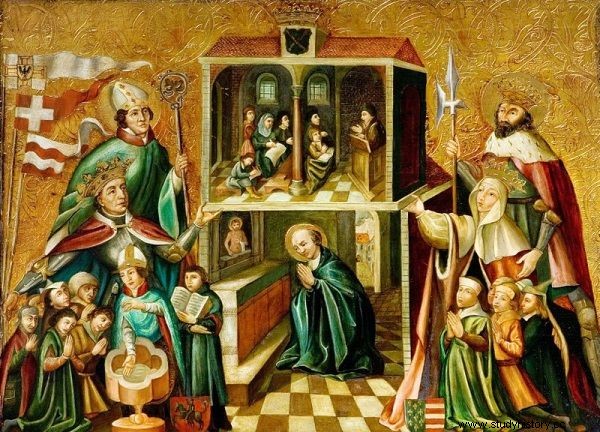Various historians competed in emphasizing how much Jadwiga Andegaweńska was unhappy in the forced, political relationship with the "bear" from Lithuania. Let's try to figure out how it really was.
It is difficult to say something certain about the marriage of a Hungarian princess with a neophyte from Lithuania. Several colorful legends from Jadwiga's childhood have survived (for example, about her great, unfulfilled love for Wilhelm Habsburg) and stories about her arrival in Poland. First, the princess, who was only 11 years old at the time, was kidnapped by the Duke of Mazovia, Siemowit IV.
Then Wawel stormed the rejected William on his own, wanting to complete the "children's weddings" concluded a few years earlier ( sponsalia de futuro ). One of the stories even tells about Jadwiga, who, with an ax in her hand, tried to break through the gates of the castle, and then escape with her "beloved" to Silesia ... It is difficult, however, to believe the fantasies of Długosz.

Jadwiga and Jagiełło in the painting by Jan Matejko.
Chronicles and sources say much less about the relationship between Jadwiga and Jagiełło. The legends end in the story of how Jadwiga sent one of the courtiers to make sure in the bathhouse that Jagiełło was not some bear with hair overgrown.
Later, we can basically only rely on the records of Jagiełło's travels ( itinerarium ) and on the unreliable propaganda of the Teutonic Knights. It is better to reject Długosz in advance - he did not like Jagiełło so much that it is hard to believe that he could write something honest about his marriage.
The whole thing is additionally complicated by the fact that in fact it is still unknown what was the age difference between the newlyweds. The old literature claimed it was 20 years.
In the 1990s, the concept of shortening this period to 10 years became popular, but the author of Jadwiga's latest biography (Jarosław Nikodem) again writes about the almost twenty-year age difference.
Marriage? More like a total disaster!
Let's go over ad rem . The traditional vision of Jadwiga and Jagiełło's marriage was perfectly presented by Ewa Maleczyńska:
was mismatched with age, culture, and the whole world of concepts. It is obvious that personal alienation exceeded the usual measure of marital relations resulting from political treaties. This was joined by the queen's sterility [who] (...) childless almost to the end, Jagieła's dynastic idea remained completely foreign .

Was the baptism of Lithuania worth a failed marriage and a broken heart?
W. Maciejewska spoke in a similar vein: Different preferences and habits, resulting from the difference of cultures and upbringing, could not bring closer this, after all, the wrong relationship . Many authors emphasized how great a sacrifice the Hungarian princess had made:for the good of the Church and both nations (as if there was such a thing as "nation" in those days), she gave up personal happiness.
Janusz Kurtyka explicitly emphasized that as a relationship purely political Andegavenko's marriage to a Lithuanian simply could not be happy. Other historians also ruled out that there was any bond between the young couple based on (as Jarosław Nikodem put it) harmony or marital love.
Jagiełło was reportedly unable to give Jadwiga what a woman expects in a marriage . Jadwiga Stabińska went so far as to ridicule the Lithuanian pagan customs in the book "Królowa Jadwiga":
You can imagine how much composure on the part of the Queen his little quirks like turning three times around before leaving the house, or throwing a crumpled straw behind him or hair torn out of the house. beards. Little things can drive you crazy.

Unhappy Jadwiga tries to run away to her first fiancé ... Truth or fiction?
Was that what it was like? Jadwiga in silence, like a martyr, endured the relationship with the superstitious and suspicious crypto-pagan who did not grow up to her level?
Or was it completely different?
Another vision of the marriage of probably the most famous Polish royal couple was outlined in his book (Jadwiga. Król Polski) by the already mentioned Jarosław Nikodem.
Professor of the University of Adam Mickiewicz suggested that Jadwiga and Jagiełło could have much more than one might think. Only that it was not necessarily (at least at first) a marriage bond. The author spins the following concept:
What could the young, still quite lonely in Krakow, not seeing her mother, expect a much older husband from her when she met him?
Support, feelings of closeness, or perhaps above all, care? We are guessing - it cannot be otherwise - but it seems that this is the most likely suggestion. (…)
At the beginning of the marriage, nothing else could have linked them together. Neither real life, nor community of interests, nor political issues, nor adult life partnership.
If the king managed to make Jadwiga perceive him as a guardian, almost a father, although it would probably be neater to write an older brother, there could be no future alienation between them. .

We know Jadwiga mainly from the fact that she left her crown jewels to the Krakow Academy.
Was Jagiełło really (or could have been) a father figure for Jadwiga? The author cites a lot of arguments to support such a concept. Of course, without hard historical sources at our disposal, we can only speculate.
For me personally, the vision of a marriage that is not without problems, but is nevertheless based on some kind of bond, is more convincing than the image of the wasted, suffering life of a young queen, sacrificing herself for the greater good.
Complementary:
- Jadwiga Krzyżaniakowa, Jerzy Ochmański, Władysław II Jagiełło , Ossolineum, Wrocław 2006.
- Stanisław Andrzej Sroka, Queen Jadwiga , WAM, Krakow 2002.
- Jadwiga Stabińska, Queen Jadwiga , Znak, Kraków 1975.
